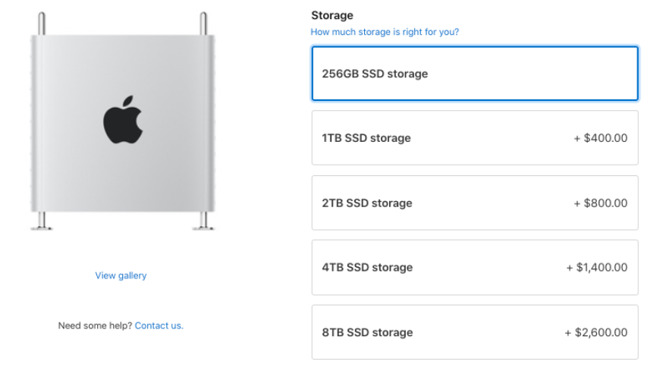Mac Pro now available with $2600 8TB SSD option
Following its initial launch without the option, Apple has updated the ordering page for the modular Mac Pro with a new storage capacity, with customers now able to configure a version with up to 8 terabytes of built-in storage.

When the new Mac Pro initially became available to order, customers were able to order up to 4TB of built-in SSD storage, comprising of two 2TB modules. Specification pages and other marketing materials advised of configurations where 8TB were possible, but that option wasn't offered within the configuration screen on the Apple website.
An update to the sales page on Thursday adds in the extra option, which adds two 4TB SSD modules to the system, and brings the total list of options up to five: 256GB, 1TB, 2TB, 4TB, and 8TB.
Selecting 8TB of storage is a costly upgrade to make, with a move from the base 256GB SSD to the 8TB version increasing the price of the Mac Pro by $2,600. A similar upgrade from 256GB to 4TB raises the price by $1,400.
The change in storage capacities is the only real change made to the Mac Pro ordering process, but more alternatives for other components are still on the way. The page advises options to use one or two Radeon Pro W5700X GPUs with 16GB of GDDR6 memory apiece will be available to add to an order "soon."
The extra storage now means the most expensive configuration of hardware for the Mac Pro is now $53,948, which includes peripherals and wheels but not the Pro Display XDR nor pre-installed software. Previously, the maximum hardware configuration possible was $52,748.

When the new Mac Pro initially became available to order, customers were able to order up to 4TB of built-in SSD storage, comprising of two 2TB modules. Specification pages and other marketing materials advised of configurations where 8TB were possible, but that option wasn't offered within the configuration screen on the Apple website.
An update to the sales page on Thursday adds in the extra option, which adds two 4TB SSD modules to the system, and brings the total list of options up to five: 256GB, 1TB, 2TB, 4TB, and 8TB.
Selecting 8TB of storage is a costly upgrade to make, with a move from the base 256GB SSD to the 8TB version increasing the price of the Mac Pro by $2,600. A similar upgrade from 256GB to 4TB raises the price by $1,400.
The change in storage capacities is the only real change made to the Mac Pro ordering process, but more alternatives for other components are still on the way. The page advises options to use one or two Radeon Pro W5700X GPUs with 16GB of GDDR6 memory apiece will be available to add to an order "soon."
The extra storage now means the most expensive configuration of hardware for the Mac Pro is now $53,948, which includes peripherals and wheels but not the Pro Display XDR nor pre-installed software. Previously, the maximum hardware configuration possible was $52,748.

Comments
Now, why do wheels add a month to the delivery time? Wheels should make it faster.
Update: Otherworld Computing (macsales.com) is now selling a PCI SSD for Mac Pro that provides "over 6GB/s real world" speed.
It seems to me that they're better thought of as storage memory modules, almost like regular RAM modules, except with persistent memory. They're essential components of an SSD, but not an SSD themselves.
This is unfortunate for Mac Pro owners who might want to substitute their own solid state storage for the Apple modules. Of course they could use regular PCIe drive cards.
I want 16tb.
Indeed. I amused myself with a Linus Tech Tips (LTT) YouTube video last night where he put together an impressive petabyte disk array.
While I certainly have the chops to do such a thing myself, my hourly billing rate (and that of many professionals) dictates that any time spent worrying about hardware issues or downtime due to flaky third-party memory is simply not worth it. An hour spent diagnosing a problem that causes my team to lose an hour of work is a five-figure loss, not to mention the loss of reputation.
I am hoping Apple comes to market with a still more Pro Mac Pro. Maybe dual-socket CPU complex for twice the cores. And I have projects that approach 8 TB, and would eagerly buy 32 TB for an extra $10K.
An 8K pro sensor (just the sensor, not the whole camera) costs more than a fully-loaded Mac Pro. See https://www.red.com/dsmc2 High quality glass (lenses) can be five figures easily.
The reason why more "pro" users aren't responding to this nonsense about the Mac Pro being "expensive" is that they're too busy making money, not trying to save $500. Speaking of which...
Uh, wrong — that's the whole fucking point of having 8 PCIe slots, to use them for things like fast storage and other third party expansion options. Same reason Promise is making their drive sleds for this box as well.
Interesting. So you could not even use the built in storage at that point, have a faster boot drive, and spend $700 less.